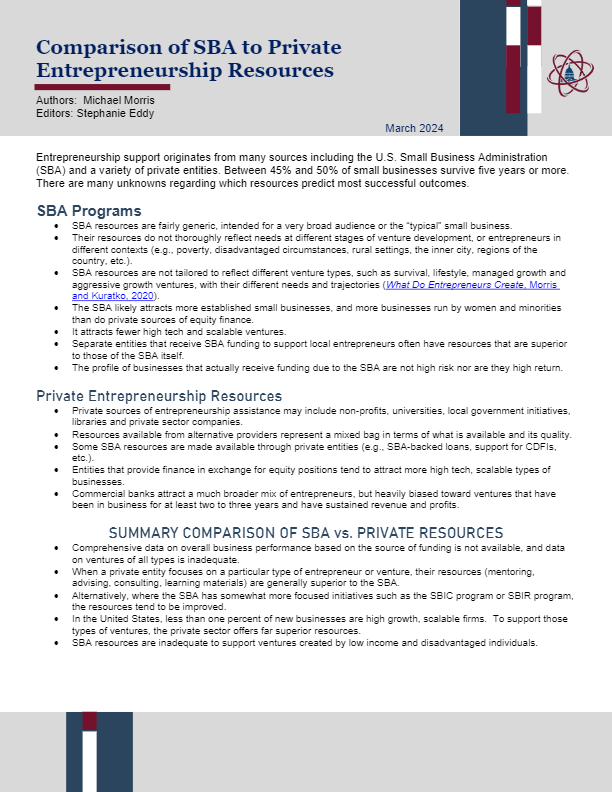
Entrepreneurship support originates from many sources including the U.S. Small Business Administration (SBA) and a variety of private entities. Between 45% and 50% of small businesses survive five years or more. There are many unknowns regarding which resources predict most successful outcomes.
SBA Programs:
- SBA resources are fairly generic, intended for a very broad audience or the “typical” small business.
- Their resources do not thoroughly reflect needs at different stages of venture development, or entrepreneurs in different contexts (e.g., poverty, disadvantaged circumstances, rural settings, the inner city, regions of the country, etc.).
- SBA resources are not tailored to reflect different venture types, such as survival, lifestyle, managed growth and aggressive growth ventures, with their different needs and trajectories (What Do Entrepreneurs Create, Morris and Kuratko, 2020).
- The SBA likely attracts more established small businesses, and more businesses run by women and minorities than do private sources of equity finance.
- It attracts fewer high tech and scalable ventures.
- Separate entities that receive SBA funding to support local entrepreneurs often have resources that are superior to those of the SBA itself.
- The profile of businesses that actually receive funding due to the SBA are not high risk nor are they high return.
Private Entrepreneurship Resources:
- Private sources of entrepreneurship assistance may include non-profits, universities, local government initiatives, libraries and private sector companies.
- Resources available from alternative providers represent a mixed bag in terms of what is available and its quality.
- Some SBA resources are made available through private entities (e.g., SBA-backed loans, support for CDFIs, etc.).
- Entities that provide finance in exchange for equity positions tend to attract more high tech, scalable types of businesses.
- Commercial banks attract a much broader mix of entrepreneurs, but heavily biased toward ventures that have been in business for at least two to three years and have sustained revenue and profits.
SUMMARY COMPARISON OF SBA vs. PRIVATE RESOURCES
- Comprehensive data on overall business performance based on the source of funding is not available, and data on ventures of all types is inadequate.
- When a private entity focuses on a particular type of entrepreneur or venture, their resources (mentoring, advising, consulting, learning materials) are generally superior to the SBA.
- Alternatively, where the SBA has somewhat more focused initiatives such as the SBIC program or SBIR program, the resources tend to be improved.
- In the United States, less than one percent of new businesses are high growth, scalable firms. To support those types of ventures, the private sector offers far superior resources.
- SBA resources are inadequate to support ventures created by low income and disadvantaged individuals.
The Research-to-Policy Collaboration (RPC) works to bring together research professionals and public officials to support evidence-based policy. Please visit their website to learn more.
Key Information
RPC Website
Research-to-Policy Collaboration
Publication DateMarch 6, 2024
Topic Area(s)Economy and Entrepreneurship
Resource TypeWritten Briefs
Share This Page
Entrepreneurship support originates from many sources including the U.S. Small Business Administration (SBA) and a variety of private entities. Between 45% and 50% of small businesses survive five years or more. There are many unknowns regarding which resources predict most successful outcomes.
SBA Programs:
- SBA resources are fairly generic, intended for a very broad audience or the “typical” small business.
- Their resources do not thoroughly reflect needs at different stages of venture development, or entrepreneurs in different contexts (e.g., poverty, disadvantaged circumstances, rural settings, the inner city, regions of the country, etc.).
- SBA resources are not tailored to reflect different venture types, such as survival, lifestyle, managed growth and aggressive growth ventures, with their different needs and trajectories (What Do Entrepreneurs Create, Morris and Kuratko, 2020).
- The SBA likely attracts more established small businesses, and more businesses run by women and minorities than do private sources of equity finance.
- It attracts fewer high tech and scalable ventures.
- Separate entities that receive SBA funding to support local entrepreneurs often have resources that are superior to those of the SBA itself.
- The profile of businesses that actually receive funding due to the SBA are not high risk nor are they high return.
Private Entrepreneurship Resources:
- Private sources of entrepreneurship assistance may include non-profits, universities, local government initiatives, libraries and private sector companies.
- Resources available from alternative providers represent a mixed bag in terms of what is available and its quality.
- Some SBA resources are made available through private entities (e.g., SBA-backed loans, support for CDFIs, etc.).
- Entities that provide finance in exchange for equity positions tend to attract more high tech, scalable types of businesses.
- Commercial banks attract a much broader mix of entrepreneurs, but heavily biased toward ventures that have been in business for at least two to three years and have sustained revenue and profits.
SUMMARY COMPARISON OF SBA vs. PRIVATE RESOURCES
- Comprehensive data on overall business performance based on the source of funding is not available, and data on ventures of all types is inadequate.
- When a private entity focuses on a particular type of entrepreneur or venture, their resources (mentoring, advising, consulting, learning materials) are generally superior to the SBA.
- Alternatively, where the SBA has somewhat more focused initiatives such as the SBIC program or SBIR program, the resources tend to be improved.
- In the United States, less than one percent of new businesses are high growth, scalable firms. To support those types of ventures, the private sector offers far superior resources.
- SBA resources are inadequate to support ventures created by low income and disadvantaged individuals.
The Research-to-Policy Collaboration (RPC) works to bring together research professionals and public officials to support evidence-based policy. Please visit their website to learn more.

Key Information
RPC Website
Research-to-Policy Collaboration
Publication DateMarch 6, 2024
Topic Area(s)Economy and Entrepreneurship
Resource TypeWritten Briefs
Share This Page
LET’S STAY IN TOUCH
Join the Evidence-to-Impact Mailing List
Keep up to date with the latest resources, events, and news from the EIC.




